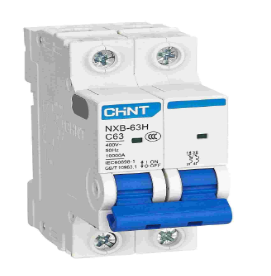double pole circuit breaker

A double pole circuit breaker is an electrical protection device that can simultaneously control and protect two circuits (usually the live wire and the neutral wire), and is widely used in scenarios where synchronous disconnection or protection of single-phase circuits is required. The following is a detailed analysis from aspects such as technical characteristics, application scenarios, and selection key points:
I. Core Technical Characteristics
1. **Structure and Function*CHINT circuit breaker price*
- **Bipolar Linkage**: It contains two independent but mechanically linked contact systems inside, which can simultaneously connect or disconnect two lines (such as the live wire L and the neutral wire N in a single-phase circuit), ensuring that the power supply is synchronously cut off during operation and avoiding the risk of the neutral wire being live.
- **Tripping Protection*CHINT contactor price*:
- **Thermal-Magnetic Tripping**: It has both overload protection (thermal element) and short-circuit protection (electromagnetic trip device), with a fast response speed (instantaneous tripping during a short circuit and time-delay tripping during an overload).
- **Interrupting Capacity**: It indicates the rated short-circuit breaking capacity (such as 6kA, 10kA), which needs to match the maximum expected short-circuit current of the circuit.
2. **Rated Parameters*CHINT surge protector price*
- **Rated Current (In)**: Common specifications are 16A, 20A, 32A, 63A, etc., and it needs to be greater than the maximum working current of the circuit (it is recommended to reserve a margin of 1.2 to 1.5 times).
- **Rated Voltage (Un)**: It is suitable for single-phase 220V/230V circuits (such as for household use) or single-phase branches in a three-phase system (such as for industrial control).
- **Tripping Curve*Chint NXR series thermal overload relays price*:
- **Type C**: Conventional power distribution (suitable for lighting and socket circuits, with a tripping current of 5 to 10 times In).
- **Type D**: High-impact loads (such as motors and transformers, with a tripping current of 10 to 20 times In).
II. Typical Application Scenarios
1. **Residential Power Distribution System**
- **Main Switch or Branch Circuit**: As the main switch of the household distribution box (such as a 63A double pole circuit breaker), or an independent circuit for controlling high-power devices (such as air conditioners and electric water heaters), it can cut off both the live wire and the neutral wire at the same time, improving the safety of maintenance.
- **Electric Floor Heating/Heat Pump System**: Such devices have a relatively large working current and require the return of the neutral wire, and the double pole circuit breaker can provide reliable protection.
2. **Commercial and Light Industry Scenarios**
- **Single-Phase Control of Small Three-Phase Devices**: For example, in the single-phase lighting and office equipment circuits in a three-phase system, using a double pole circuit breaker can avoid device abnormalities caused by neutral wire faults.
- **Fire Protection/Emergency Circuits**: In the fire protection linkage system, the double pole circuit breaker can ensure that non-essential power supplies are synchronously cut off during a fire to prevent the risk of electric shock.
3. **Industrial Control and Equipment Protection**
- **Single-Phase Motor Control**: For example, in the power supply circuits of small conveyors and fans, it cooperates with contactors to achieve start-stop control, and at the same time provides overload/short-circuit protection.
- **Battery Energy Storage System**: In DC systems such as photovoltaic energy storage and UPS, the double pole circuit breaker can cut off the positive and negative poles to prevent reverse current and short circuits (a DC-specific model needs to be selected).
III. Comparison with Single Pole/Three Pole Circuit Breakers
| Type | Controlled Lines | Safety | Typical Applications | Current Range |
| Single Pole (1P) | Only the live wire (L) | The neutral wire is still live, and the maintenance risk is relatively high | Ordinary lighting, low-power socket circuits | 6A~63A |
| Double Pole (2P) | Live wire + neutral wire (L+N) | Synchronously cut off L+N, providing more safety against electric shock | High-power devices, main switches, industrial control | 16A~125A |
| Three Pole (3P) | Three-phase live wires (L1+L2+L3) | Control three-phase circuits, without cutting off the neutral wire | Three-phase motors, industrial distribution cabinets | 63A~630A |
IV. Selection and Installation Key Points
1. **Selection Principles**
- **Current Matching**: Calculate the current according to the load power (for example, the current of a 3kW device is approximately 13.6A, and a 16A double pole circuit breaker should be selected).
- **Interrupting Capacity**: Select 6~10kA for residential use, and higher values (such as 15kA, 25kA) for industrial environments.
- **Certification Standards**: In China, a 3C certification is required, and for export, certifications such as CE and UL are needed to ensure compliance with local electrical codes.
2. **Installation Precautions**
- **Wiring Specifications**: Connect the live wire to the inlet terminal of the circuit breaker (marked "L"), and connect the neutral wire to "N" (in some models, the neutral wire has no protection, and the product instructions need to be confirmed).
- **Power Distribution Layout**: Install it in the distribution box, reserve enough space for heat dissipation, and avoid the performance being affected by the heat generated by adjacent circuit breakers.
- **Coordination with Leakage Protection**: If leakage protection is required, a double pole leakage circuit breaker (2P + leakage module) can be selected to provide overload, short-circuit, and leakage protection at the same time.
3. **Common Brands and Models**
- **Schneider**: iC65N 2P C63A (with an interrupting capacity of 6kA, a preferred choice for household use).
- **CHINT**: NXB-63 2P D32A (Type D tripping, suitable for motor loads).
- **ABB**: S200 series 2P C63A (with high reliability, commonly used in industrial scenarios).
V. Maintenance and Fault Troubleshooting
1. **Regular Inspections**
- **Appearance**: Observe whether the housing has changed color or shape, and whether the wiring terminals are loose (it is recommended to tighten them with a torque wrench according to the standard, such as 1.5N·m for an M4 screw).
- **Function Testing**: Press the "Test" button every month (for leakage circuit breakers), and simulate overload/short circuit with a special tester every year to verify whether the tripping is normal.
2. **Common Faults**
- **Frequent Tripping**: It may be due to load overload, line short circuit, or the circuit breaker being too small in size, and the load current needs to be checked level by level.
- **Failure to Close the Breaker**: Check whether there is a short-circuit fault that has not been eliminated, or whether the trip device is stuck internally (the circuit breaker needs to be replaced).
- **Neutral Wire Being Live**: Confirm whether the circuit breaker cuts off both poles simultaneously, or whether the neutral wire terminal block has poor contact.
VI. Summary
The double pole circuit breaker, by synchronously controlling the live wire and the neutral wire, is superior to the single pole circuit breaker in terms of safety and reliability, especially suitable for scenarios with high-power loads and frequent maintenance. When selecting a circuit breaker, it is necessary to combine the load type, current and voltage parameters, and installation environment to ensure the effective operation of the protection function. In the residential, commercial, and industrial fields, the reasonable configuration of double pole circuit breakers is an important part of building a safe electrical system.


